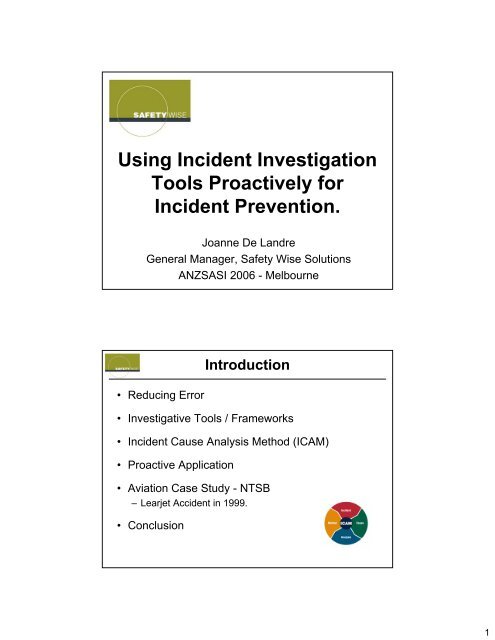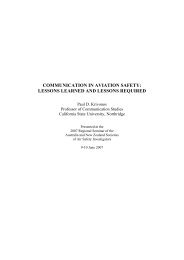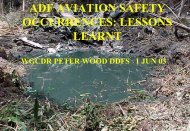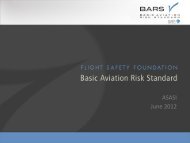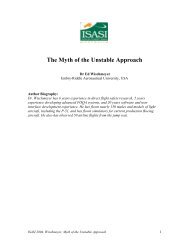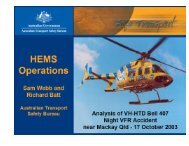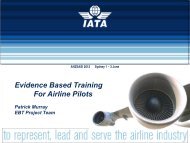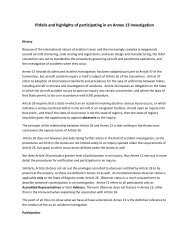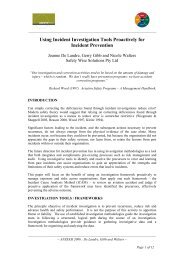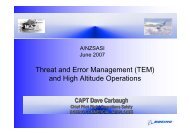Using Incident Investigation Tools Proactively for Incident ... - ASASI
Using Incident Investigation Tools Proactively for Incident ... - ASASI
Using Incident Investigation Tools Proactively for Incident ... - ASASI
Create successful ePaper yourself
Turn your PDF publications into a flip-book with our unique Google optimized e-Paper software.
<strong>Using</strong> <strong>Incident</strong> <strong>Investigation</strong><strong>Tools</strong> <strong>Proactively</strong> <strong>for</strong><strong>Incident</strong> Prevention.Joanne De LandreGeneral Manager, Safety Wise SolutionsANZSASI 2006 - MelbourneIntroduction• Reducing Error• Investigative <strong>Tools</strong> / Frameworks• <strong>Incident</strong> Cause Analysis Method (ICAM)• Proactive Application• Aviation Case Study - NTSB– Learjet Accident in 1999.• Conclusion1
Reducing Error• Can simply correcting the deficiencies foundthrough incident investigations reduce error?– Modern safety theory suggests that relying on correctingdeficiencies found through incident investigation as ameans to reduce error is restrictive.• Many incidents occur, not because they cannot beprevented, but because of:– Gaps in their safety systems,– Failing to learn or retain the lessons from past incidents.• Future direction <strong>for</strong> incident prevention:– using investigation methodologies as a tool that integratewith and compliment pre-existing processes.<strong>Investigation</strong> <strong>Tools</strong>/Frameworks• Principle objective:– Prevent recurrence, reduce risk and advance health andsafety per<strong>for</strong>mance.• Provide guidance <strong>for</strong> the <strong>Investigation</strong> Team.• Effectiveness in reducing error needs improvement.– Not focused on, there<strong>for</strong>e not truly effective at makingorganisations “safer”.• Good investigative tools / frameworks are able tobe used not only reactively, but also proactively.• ICAM– Holistic tool.– Improve safety at an organisational level.2
<strong>Incident</strong> Cause AnalysisMethod - ICAM• ICAM stems from the work of Professor Reason andhis modelling of organisational accidents.• Systems approach - not only looks at whathappened, but why it happened.• Designed to ensure that the investigation is notrestricted to the errors and violations of operationalpersonnel.• ICAM is an analysis tool that sorts the findings of aninvestigation into a structured frameworkconsisting of four elements.ICAM Model ofAccident Causation3
Objectives of ICAM• The objectives of incident investigations usingICAM:– Establish the facts– Identify contributing factors and latent hazards– Review the adequacy of existing controls and procedures– Report the findings– Recommend corrective actions which can reduce riskand prevent recurrence– Detect organisational factors that can be analysed toidentify specific or recurring problems– Identify key learnings <strong>for</strong> distribution• It is not the purpose of an ICAM <strong>Investigation</strong> toapportion blame or liability.Applying ICAM <strong>Proactively</strong>• Extremely effective reactive tool– Development of safety per<strong>for</strong>mance improvementstrategies.• Future direction – proactive use of the model.• For incident reduction to occur, precursors to errormust be identified and rectified.• Error management systems needed to:– Reduce error,– Mitigate the consequences of error; and– <strong>Proactively</strong> prevent incidents.4
ICAM ErrorManagement Strategy• 3-way strategy to manage workplace errors.DEFENCESErrorPreventionErrorTrappingErrorMitigationSafe OperationsManaged RiskORG.FACTORSApplying ICAM <strong>Proactively</strong>5
Case Study• ICAM is used widely <strong>for</strong> the investigation ofincidents throughout the aviation, rail, mining,marine, medical and petroleum industries.• Aviation Case Study - demonstration of how theproactive use of ICAM may have identifiedprecursors to error, effectively breaking the linksthat led to the accident.• Learjet Accident–25 th October 1999– Near Aberdeen, South Dakota USA– Pax included Professional Golfer,Payne Stewart.Accident Summary• Learjet Model 35 (N47BA) flown from San<strong>for</strong>d onthe morning of the accident to Orlando Florida,where passengers boarded.• Flight departed Orlando <strong>for</strong> ‘Love Field’ in Dallas,Texas with two pilots and four passengers atapprox. 0919 hours.– Planned flight time: 2 hours– Fuel - Aircraft had approx. 4 hours & 45 minutes flyingtime.• Air Traffic Control cleared theaircraft to FL 390 at 0944 hours– aircraft was NW of Gainesville,Florida, climbing through 37,000 ft.6
Accident Summary• ATC lost radio contact with the flight at this point.• The aircraft proceeded on a northwest heading atapproximately 45,000 ft.• Alarm raised – aircraft intercepted by militaryaircraft.– Pilots reported the <strong>for</strong>ward windshields seemed to befrosted over or covered with condensation.– No structural anomalies or other unusual conditionsnoted.• At 1326 hours, the Learjet departed controlled flightand spiralled to the ground– All occupants sustained fatal injuries– Aircraft destroyedAccident Summary• Diagram shows planned route and deviation.7
Accident Summary• Aerial photograph to the right displays emergencyvehicles parked near the site - Learjet wreckagecircled in red.• Investigators at the accident site.Accident Summary• Rescue workers at the accident site• FAA Investigator at theaccident site.8
• NTSB<strong>Investigation</strong> Challenges– Difficult investigation – much of the physical evidencedestroyed.– As the aircraft impacted at nearly supersonic speed andat an extremely steep angle, none of its componentsremained intact.– The airplane was not equipped with a flight data recorderand it had only a 30-minute cockpit voice recorder, whichwas of limited use during the investigation.– All of the investigators involved in theinvestigation were also investigatingother accidents. The Investigator-in-Charge was working on four otherinvestigations in addition to this one.Probable Cause of Accident• NTSB Findings:– Incapacitation of the flight crew members as a result oftheir failure to receive supplemental oxygen following aloss of cabin pressurisation, <strong>for</strong> undetermined reasons.– The Safety Board was unable to determine why the flightcrew could not, or did not, receive supplemental oxygenin sufficient time and/or adequate concentration to avoidhypoxia and incapacitation.• ICAM applied to the accident based on thecontributing factors identified in the NTSB Report.9
Reactive Use of ModelICAM ModelOrganisationalFactorsTask /EnvironmentalFactorsIndividual /Team ActionsAbsent / FailedDefencesAdverseOutcomeSoundOrganisationalFactorsProducesSafeWorkplaceReducesErrors &ViolationsSafety netRedundancyRisk managementError trapsError mitigationSafe & efficienttask completionManagementControlsFormal riskAssessments,Design etc.Risk andBehaviouralInfluencesJob SafetyAnalysis etc.Risk TakingBehaviourTake 2, RiskBasedDecisionMaking etc.RiskControlsAudits etc.DesiredOutcomeRisk Management ModelApplication of ICAM• Absent / Failed Defences– Unable to maintain cabin pressurisation– Lack of bleed air supply to the cabin– Closed flow control valve (supplying warm air towindshield)– Timeliness/warning <strong>for</strong> donning oxygen masks– Oxygen quality/quantity– Incomplete standardised manual and procedures– Previous inconsistencies in application of SOP’s– Crew pairing of inexperienced captain and first officer– Limited flying time on type by Captain– Maintenance procedures not adhered to, some verbal,incomplete written, some not signed off.10
Application of ICAM• Individual / Team Actions– Crew did not don oxygen masks in a timely manner– Crew did not detect the onset of hypoxiaApplication of ICAM• Task / Environmental Conditions– Loss of cabin pressurisation– Flow control valve closed– Limited time of type– Altitude– Low pressure evident in cabin (via alarm)– Ambiguity surrounding effectiveness of alarm system– Lack of supplemental oxygen– Hypoxia / Incapacitation11
• Organisational FactorsApplication of ICAM– Deficient monitoring/ auditing of maintenance itemcompletion– Equipment not fit <strong>for</strong> purpose- suspected valve problemswith closure of flow control valve.– Process of managing the introduction of new aircraft.– <strong>Incident</strong> reporting system deficiencies.– Inadequate procedures <strong>for</strong> checking quality and quantityof on board emergency oxygen bottle.– Deficiencies in maintenance control – use of MEL etc.– No evidence of risk appreciation process used.Application of ICAM• Organisational Factors cont…•– Ambiguous monitoring by management of resources,climate and processes of a safe working environment.– Incomplete corporate commitment to safety.– Failure to revise maintenance strategy.– Failure to appreciate the risk exposure or vulnerabilitywithin the organisation.– No follow-up from previously failed defenses –identification, tracking and resolving maintenance itemsand adverse trends.12
Proactive Use of ModelICAM ModelOrganisationalFactorsTask /EnvironmentalFactorsIndividual /Team ActionsAbsent / FailedDefencesAdverseOutcomeSoundOrganisationalFactorsProducesSafeWorkplaceReducesErrors &ViolationsSafety netRedundancyRisk managementError trapsError mitigationSafe & efficienttask completionManagementControlsFormal riskAssessments,Design etc.Risk andBehaviouralInfluencesJob SafetyAnalysis etc.Risk TakingBehaviourTake 2, RiskBasedDecisionMaking etc.RiskControlsAudits etc.DesiredOutcomeRisk Management ModelIdentifying the Precursors• Application of a proactive tool may have been ableto identify the precursors and break the error chain.• Given the contributing factors found and the typesof issues that are typically found during theproactive application of ICAM:•– Poor follow through on work procedures.– Incomplete standardised manual and procedures.– Monitoring / audit processes.– Change management issues (new aircraft).– Crew pairing– Risk Management– Procedures <strong>for</strong> checking quality/quantity of oxy bottle.13
Benefit of Proactive Approaches• Proactive error mangement strategy that leads tooverall incident reduction is beneficial and can bemeasured in both tangible and intangible means.• The proactive use of tools such as ICAM canprovide safety learnings without the costsassociated with an incident.• By designing error tolerant workplaces that willreduce error, organisations have the potential tomitigate error consequences and there<strong>for</strong>e,proactively prevent incidents.• Shift in focus from investigation findings topreventative safety.• “Our investigation and corrective actionstend to be based on the amount of damageand injury – which is random. We don’treally have prevention programs; we haveaccident correction programs.”– Richard Wood (1997). Aviation Safety Programs – A ManagementHandbook.14
Conclusion• Correcting the deficiencies found using standardreactive incident investigation methods shouldreduce and manage the errors that led to aparticular incident.• However, to reduce the precursors to error andfundamentally improve the safety of anorganisation, a more proactive approach isrequired.• The proactive use of investigation methodologiesmay enable the precursors to error to be identifiedand remedied prior to actual occurrences….. savingtime, money and perhaps lives.Further DetailsJoanne De LandreGeneral Manager - Safety Wise SolutionsEmail:jo.delandre@safetywisesolutions.comMobile: 0414 804 77115


